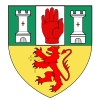Merville Garden Village
Merville Garden Village is a housing estate located at Shore Road, Whitehouse, Newtownabbey, County Antrim, Northern Ireland created by structural and landscape architect Edward Prentice Mawson. It was completed in 1949.
Historical background
Merville was originally a private house, the modern-day Merville House, and estate built in 1795 by the Belfast banker and merchant John Brown (c.1740-1808). It was intended as his country retreat. Other fêted people would come to reside at the sprawling 24-acre shoreline manor.
Between 1849-1887, for example, it was the home of Sir Edward Coey (1805–87), noted as the first and only Liberal Party Mayor of Belfast (1861) and prominent wealthy businessman, who helped make Belfast one of the most prosperous manufacturing centres in the world during the 19th century.
However, between 1947-49 the Garden Village, the first such housing development in Ireland, was constructed. It was the idea of Lurgan-born builder Thomas McGrath who had established his company, Ulster Garden Villages Limited, in January 1946. Merville was designed with a French architectural twist, which initially influenced McGrath when serving in France as a Royal Engineers' soldier in the First World War.
English architect Edward Prentice Mawson, eldest son of the garden designer Thomas Hayton Mawson, became McGrath's choice of architect for the project after being introduced to him by his site manager Jesse Williams who previously worked with Mawson in England. Mawson was the consultant architect of all of McGrath's ambitious Garden Village schemes in Northern Ireland. Apart from Merville these were at Abbots Cross, Fernagh, Prince's Park, King's Park, Muckamore and Whitehead, all in County Antrim. The Merville development was of 256 apartments, 28 cottage flats, 146 terraced and semi-detached houses and a row of 14 shops. The building work was completed in 1949.
Conservation Area designation
Merville Garden Village was designated a conservation area on 23 June 1995 because of its unique architecture and landscape and is the only neighbourhood in the borough of Newtownabbey to have this protection.[1]
Merville House restoration
In April 2000 Patricia Pepper, Jackie Thompson and Brian McNally began the restoration of Merville House when they met Belfast Regeneration Office officials, amongst others. The meeting with potential funders was initiated by local North Belfast MLA Fred Cobain after a chance meeting with MRA committee member Barbara McPhee. However, Stephen Hamilton, another Merville resident, joined the committee and formally set up Merville House Limited in February 2002 to help garner funding for the project. Other key players in the Merville House team included the late Jacqui Thompson, and Carol and Colin Simms who assisted with grant applications. The scheme was ultimately funded by Ulster Garden Villages Limited, International Fund for Ireland, Newtownabbey Borough Council, Newtownabbey Local Strategy Partnership and Belfast Local Strategy Partnership and a private donor. The house was officially re-opened on 27 April 2006 by Baroness Blood, a well-known community activist in west Belfast. Today Merville House is utilised by the whole community.
60th anniversary celebration
On 25 September 2009 a celebration was organised by Merville Residents' Association to mark the 60th anniversary of the completion of the village with guest of honour Thomas Prentice Mawson,[2] the son of Edward Prentice Mawson. Thomas was a member of the original Merville design team led by his father. Other dignatories at the event included incumbent Alderman John Scott, Mayor of Newtownabbey, and Tony Hopkins CBE, the head of Ulster Garden Villages Limited.
References
See also
Coordinates: 54°39′21″N 5°54′46″W / 54.65583°N 5.91278°W
